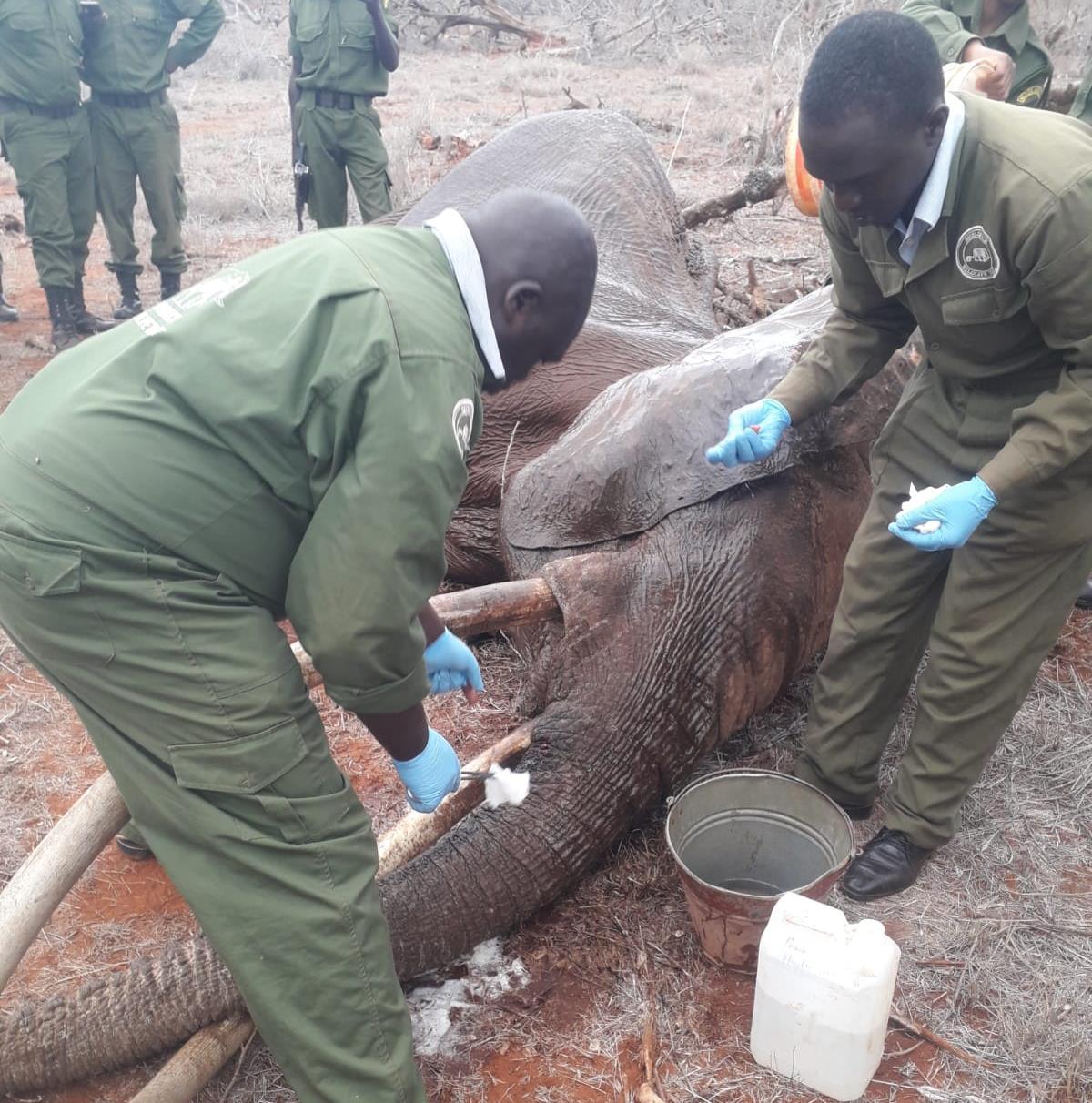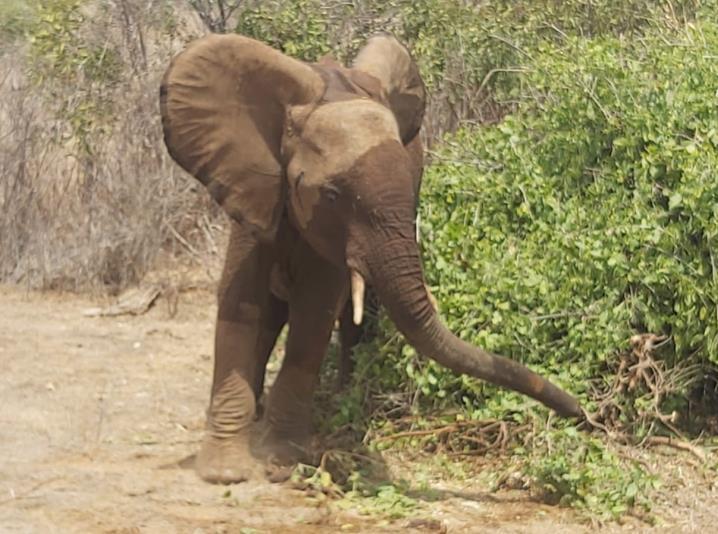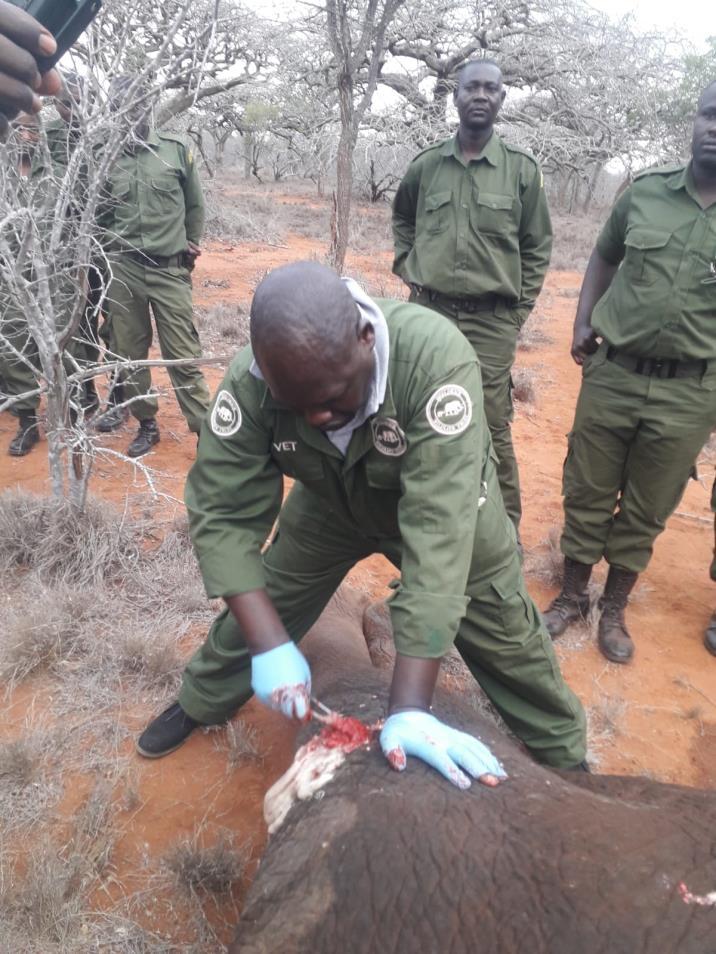


SWT/KWS TSAVO MOBILE VETERINARY UNIT AUGUST 2022
forage is increasingly becoming
is expected to persist for the better part of the

August 2022, 6 of these cases involved elephants.

a knee sprain after hunting down an impala. All cases were attended to successfully.
other 2 cases
Vier
support.
 August
August
Report
by Dr. Campaign Limo
The drought situation is still dire in the entire Tsavo Conservation Area,
scarce and many water pans are completely dry. The dry season
year. The Tsavo Mobile Veterinary Unit attended to 8 cases in
The
involved a snared zebra and a cheetah that sustained
Acknowledgement The Tsavo mobile Veterinary unit would like to thank all stakeholders who contributed to the success of various interventions they carried out this month. We also wish to thank
Pfoten for their on going support through the Sheldrick Wildlife Trust and KWS management for offering technical
8 Cases in August 4 Poaching Cases 6 Elephant Cases Date Species Area Found Reason for Intervention Outcome 17 Aug 22 Zebra Manyani Prison Snared Seen dragging a wire snare hanging around its neck Treated successfully 20 Aug 22 Elephant Kulalu Ranch Post mortem Naturally mono tusked elephant carcass found by the KWS patrol team. The carcass had been mutilated and the only tusk cut off Died 25 Aug 22 Elephant Kanderi Swamp Natural Causes The calf had difficulty walking due to a severely swollen left knee Treated successfully 26 Aug 22 Cheetah Sentrim Area Tsavo East NP Natural Causes Walking with difficulty after successfully hunting down an impala Treated successfully 26 Aug 22 Elephant Sobo Rock Tsavo East NP Natural Causes Exhibited signs of severe lameness and was isolated from the rest of the herd Prognosis Poor 30 Aug 22 Elephant Rukinga Ranch Arrow Arrow lodged in the proximal trunk of this well known female elephant Treated successfully 30 Aug 22 Elephant Rukinga Ranch Snared Seen with a snare around the neck Treated successfully 30 Aug 22 Elephant Rukinga Ranch Arrow Seen oozing purulent exudate from the left thigh Treated successfully Introduction Case Details

SWT/KWS Tsavo Mobile Vet Unit Treatment Locations August 2022
Zebra Snared Manyani Prison
The SWT KWS De snaring Unit spotted the zebra stallion dragging a wire snare hanging around its neck Immobilisation, examination and treatment

The zebra was darted with 7 mg Etorphine hydrochloride and 60 mg of Azaperone. The drug took full effect after 8 minutes. The loose wire snare around its neck had caused some slight bruising. The plain wire snare was removed. Flunixin meglumine anti inflammatories and antibiotics were administered parenterally. Anaesthesia was then reversed with 24 mg Diprenorphine given through the jugular vein. The zebra rose one and half minutes later and joined a nearby herd.
Prognosis
The zebra has a good prognosis
Case 1 17th August 2022
Elephant Post mortem
Kulalu Ranch
A naturally mono tusked elephant carcass was found by the KWS patrol team. The carcass had been mutilated and the only tusk had been cut off. The Tsavo Vet Unit was asked to carry out a post mortem to ascertain the cause of death.
General observation
The carcass was about 2 days old and had begun to decompose. A chunk of flesh had been carved out along the elephant’s left spine, and the only tusk had been hacked off. Fresh vegetation had been placed on the carcass to conceal it.
Post-mortem findings
The carcass showed an elephant in poor body condition and nursing. The elephant was emaciated, it was suspected that the elephant died from starvation and dehydration. Evidence at the site indicated it was more probable that local people on another mission came across this carcass and opportunistically harvested the meat as opposed to the elephant being targeted by poachers. KWS security personnel are pursuing the culprits.

Case 2 20th August 2022
Elephant Natural Causes Kanderi Swamp
The SWT KWS De snaring observed the elephant calf that had difficulty walking due to a severely swollen left knee.


Immobilisation, examination and treatment
The calf appeared to be in severe pain, it found with its fiercely protective mother and a slightly older brother. The knee joint was swollen, and it was limiting the calf’s mobility. To ensure the safety of personnel and to facilitate restraining of the calf, the mother was first immobilized with 18 mg Etorphine hydrochloride. Darting was carried out from a vehicle, it took 7 minutes for the drugs to take full effect, the calf was restrained manually thereafter
Examination revealed several bite marks which were already septic and accumulating pus. This was suspected to be a case of lion predation. The abscess was lanced, then the wounds flushed with Hydrogen peroxide, rinsed with water and disinfected with Iodine. Amoxicillin antibiotics and Flunixin meglumine anti inflammatories were administered accordingly. Clindamycin antibiotic was also administered and Oxytetracycline spray applied topically on the wound.
The mother was revived then the calf was released, they both majestically strode to a nearby bush to join the other young member of their family. The ground team was advised to monitor the calf as review was indicated with possible rescue in case recuperation takes longer than expected.
Prognosis
The calf has a good prognosis.
Case 3 25th August 2022
Cheetah Natural Causes
Immobilisation, examination and treatment
The cheetah appeared to have an injury on the right hind limb since minimum weight was placed on it while walking. The cheetah was in good body condition. It was found lying close to a partially consumed impala kill The cheetah was darted from a vehicle with 130 mg Ketamine and 1.6 mg Medetomidine. The drugs took full effect after 12 minutes. Examination revealed the cheetah had sustained a knee sprain on the right hind limb. Amoxicillin antibiotics and Dexamethasone anti inflammatories were administered accordingly. There was no fracture or dislocation detected. Anaesthesia was reversed with 15 mg Atipamezole hydrochloride administered intramuscularly one hour post darting. The cheetah rose 5 minutes later and stayed close to his kill.




Prognosis
The cheetah has a good prognosis.
Case 4 26th August 2022
Sentrim Area – Tsavo East National
Park
Visitors in the park saw this Cheetah having difficulty walking after successfully hunting down an impala.
The Tsavo Mobile Veterinary Unit was driving along Galana River when they came across this young bull near the Sobo rock. The elephant was favouring its right hind limb, it exhibited signs of severe lameness and was isolated from the rest of the herd.



Immobilisation, examination and treatment
The elephant was in good body condition. The affected limb, which was favoured while moving, was slightly swollen. The elephant was darted from a vehicle with 4.5 mg Etorphine hydrochloride. The drug took full effect after 6 minutes. Examination revealed the elephant had sustained knee joint dislocation. The elephant appeared to be in severe pain and the knee area was swollen. Amoxicillin antibiotics and Flunixin meglumine anti inflammatories were administered. Anaesthesia was then reversed with 12 mg Diprenorphine administered intravenously through a prominent ear vein. He rose 2 minutes post revival and sought shelter under a nearby tree.
Prognosis
The elephant has a guarded prognosis. The ground team was advised to monitor his progress and keep the mobile veterinary unit informed for follow up treatment.

Case 5 26th August 2022
Elephant Natural Causes Sobo Rock – Tsavo East National Park
Elephant Arrow Rukinga Ranch
Rukinga ranch rangers saw an arrow lodged in the proximal trunk of this well known female elephant with long nearly crossing tusks. The elephant appeared to be in pain, and part of the arrow’s shaft could be seen.
Immobilisation, examination and treatment
The elephant was found resting under a tree with her 3 year old male calf. The elephant was darted from a vehicle with 18 mgs Etorphine hydrochloride. The drugs took full effect after 7 minutes with the female assuming left lateral recumbency. The arrow was gently removed then the penetrating wound was debrided with Hydrogen peroxide, rinsed with water and disinfected with Iodine. Cloxacillin antibiotic ointment was infused into the wound Amoxicillin antibiotics and Flunixin meglumine anti inflammatories were administered intramuscularly. Examination of the other side of the body showed an old arrow wound on her left armpit which had since healed. Anaesthesia was then reversed with 48 mgs Diprenorphine hydrochloride delivered through a prominent ear vein. The elephant struggled to rise, but it was successful after making a few attempts. A helicopter successfully guided the calf back to its mother.

Prognosis
The elephant has a good prognosis since the arrow was not poisoned.
Case 6 30th August 2022
Elephant Snared Rukinga Ranch
Rukinga Ranch rangers spotted this young calf (approx. 3 years old) with a snare around the neck. The calf was in a herd of about 15 elephants near a water tank.
Immobilisation, examination and treatment
It was difficult to separate the calf from the rest of the herd, therefore the calf was darted as the herd was driven away From a helicopter, 3 mgs Etorphine was discharged with the Dan Inject darting system. The drugs took effect after 4 minutes with the calf assuming recumbency in 6 minutes. Examination revealed a tight cable wire snare around the calf’s neck causing a deep wound. The snare was cut loose then the wound was debrided with Hydrogen peroxide, cleaned with water and disinfected with Iodine. Amoxicillin antibiotics and Flunixin meglumine anti inflammatories were administered parenterally. Anaesthesia reversal was achieved with 12 mgs Diprenorphine delivered through a prominent ear vein. The calf rose 2 minutes later, and the helicopter was used to guide it towards its family

Prognosis
The calf has a good prognosis.
Case 7 30th August 2022
Elephant Arrow Rukinga Ranch
This elephant was seen within the same herd as the snared calf under case 7, the young bull (approx. 7 years old) was oozing purulent exudate from the left thigh.
Immobilisation, examination and treatment
The young bull was darted from a helicopter with 5 mgs Etorphine hydrochloride. The drugs took full effect after 7 minutes with the bull assuming right lateral recumbency. Examination revealed a deep wound filled with pus. The wound was most likely caused by an arrow though probing it yielded no foreign body. The pus was drained off, all necrotic tissue was debrided with Hydrogen peroxide then the wound was disinfected with Iodine. Amoxicillin antibiotics and Flunixin meglumine anti inflammatories were given accordingly Anaesthesia was reversed with 18 mgs Diprenorphine hydrochloride given intravenously through a prominent ear vein. The elephant rose 2 minutes post reversal and found its way to its family a short distance away.


Prognosis
The elephant has a good prognosis.
Case 8 30th August 2022





 August
August

















